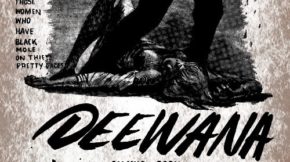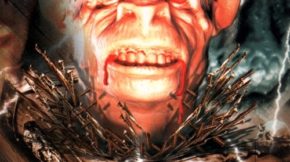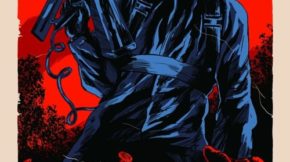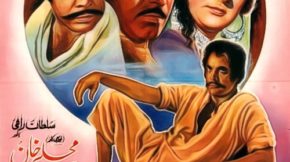This is the sort of vintage, typically Indian fairytale with an indigenous background that sadly seems to have gone out of fashion in the last decade as filmmakers and audiences have embraced a slicker, more westernized product. The fangled old yarns based on the regions own history and legends, such as the snake-themed movies revolving around reincarnation, Ichchadhari and Manidhari Naags, have all but vanished. They had enjoyed a powerful resurgence during the mid to late ’80s, with films like Sridevi’s Nagina setting the box office ablaze and demolishing numerous records along its slithery path to glory. The decade before, she had seen Reena Roy bust the box office with her rip-roaring snake-themed Nagin, one of the biggest hits of the mid-’70s.
That rare commodity followed Nagina in Bollywood; a sequel called Nigahen: Nagina 2 also did reasonably well. By the time it arrived, the snake boom was going into hibernation once again. Doodh ka Karz came in 1990 and soon had snake movie fans swaying in appreciation. The film turned into a success – especially in the rural centres where the masses invariably preferred “homegrown” ideas to imported ones – at least they did until the satellite TV revolution.
This 1990 creation is a most deliciously concocted snake melodrama epic – designed loosely on the vintage “lost and found” family dramas of the ’60s and ’70s, but the twist here is that one of the key family members is a spitting cobra! It all begins one dark stormy night at the old Thakur’s grand haveli. The ailing Thakur’s son Amrish Puri has hit hard times financially, so his evil friends convince him to swipe the jewels from the ancestral snake temple.
That fateful stormy night, the Snake Temples resident Sadhu is woken up from his slumber by a snake charmer who is desperate for shelter. His wife is about to give birth, and his beloved performing snake cum adopted son is getting wet in the driving rain. The saintly Sadhu welcomes them in and goes out into the night seeking a midwife for the woman who is just about to deliver.
Meanwhile, the dastardly Amrish and his cronies arrive to steal the jewels and are caught red-handed by the Sadhu, whom they murder by plunging a sharp dagger into his chest. The snake charmer checks to see what the disturbance is about, only to find the dead Sadhu lying there in a heap with a dagger sticking out of his chest. Moments later, the charmer is discovered by the villagers removing the dagger and is therefore incriminated as having been caught red-handed.
The innocent snake charmer is dragged off to the Thakurs who decide that he be punished till death for his robbery of the jewels and the murder of the Sadhu. As the Snake Charmer is beaten to a pulp by the Thakurs goons, his favourite snake leaps about angrily in his basket, coiling up for revenge. The charmer’s widow Aruna Irani is left with a tiny infant to look after as well as her husband’s favourite pet snake.
In a wonderfully touching scene, she is shown desperately trying to make ends meet for both her children – one human, one serpent. Finally, in a moment of brilliant “desi” cinema, Aruna offers the milk from her own breast to feed the hungry serpent who hasn’t eaten for two days. The grateful snake slurps down the milk as the film’s theme song wails away emotionally in the background. Then after the snake has gulped down the milk, Aruna tells him that though she will always love him, she is incapable of supporting him at present and that he should make his way. Before the snake takes off, his foster mother reminds him that he owes her a “Doodh ka Karz” for what she has done for him and that he and his infant brother owe it to their father, the noble snake charmer, to avenge his death and clear his name of the vile charges he was accused of. It’s a tear-jerking farewell scene as one brother is separated from his young infant brother and torn away from his angelic mother.
Years passed, and the local blacksmith rescued Aruna, who had been attacked by the Thakur and his friends and left for dead. He adopts her as a sister and her son as his nephew. The snake remains fiercely loyal and devoted to his cause and takes up residency as chief serpent at the Snake Temple, where the locals recognize him as the only snake of the hundreds that never touches the milk they offer him. Clearly, this principled snake is abstaining until he has avenged his master’s death.
The son grows up to become the handsome and brooding Jackie Shroff – a fine strapping young man who has inherited his father’s talent with the snake charmers “been” (flute) and is well on the way to becoming the most renowned snake charmer in the land. However, his mother is constantly in a foul mood, and finally, the day arrives when she informs him exactly why she suffers from a constant scowl. Jackie is advised that the beautiful young thing he has fallen for is the daughter of the man responsible for murdering his father and that he owes it to his father to salvage his tarnished reputation.
Matters came to a stunning climax when the loot was stolen from the Snake Temple is about to be sold to a foreign businessman, but not if the local reptile population can help it. The chief snake from the temple has realized that his enemies are within striking distance and he also sets off to settle old scores. Finally, in a soul-stirring finale involving flying, leaping clusters of deadly snakes and an electrifying “been” contest between an evil Tantrik and our Jackie. All dastardly deals are revealed, and all old scores settled before we are treated to a soul-stirring and emotional reunion between the two long lost brothers and their long-suffering mother.
Doodh ka Karz is truly vintage stuff for those who enjoy their snake movies full of action, with lots of snake stunts and loads and loads of ham and cheese.
One of the epic serpentine scenes in Bollywood history is the climactic scene where the snakes arrive at the masse gate, crashing the villain’s party and causing untold slithery mayhem.
Aruna Irani is in her element in her role as the vengeful snake charmers widow. She has always been great at delivering the most cheesy lines and the most cliché ridden dialogues with an air of conviction and here she proves again that she is an actress well capable of making the most of her material however ludicrous it might be.
Jackie Shroff is fine as the junior snake charmer, though he appears most awkward during the obligatory song and dance sequences. As the vivacious Thakur’s daughter, Neelam looks pretty but resembles a Barbie doll and acts like one too. The posse of villains is impressive, with Sadashiv Amrapurkar stealing the honours from an impressive Amrish Puri and a comical Prem Chopra.
The film is a rollickingly enjoyable snake yarn done in the most wonderful old fashioned and traditional style – emphasizing all the “Indian-ness” of Bollywood films of eras gone by before they went through an identity crisis and turned into Hollywood clones since the turn of the Millennium. The film is nothing more than a desi fairytale, but it is done with such a healthy dose of nostalgic charm and style and contains such a delightfully high quotient of vintage cheese that it comes up a winner all the way—essential viewing for those who have a weakness for snake oriented movies.
















